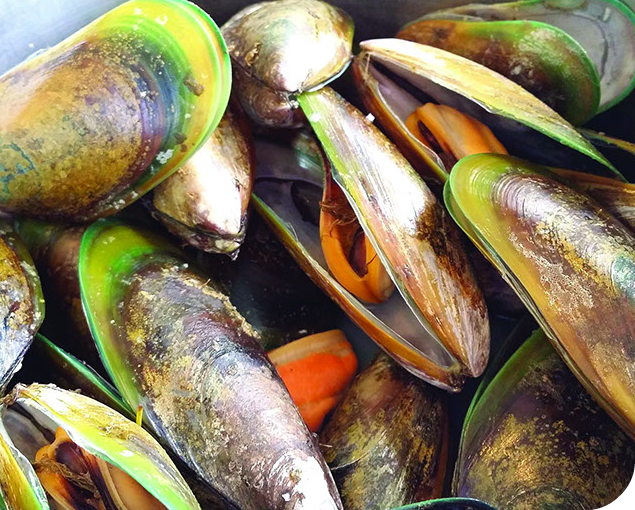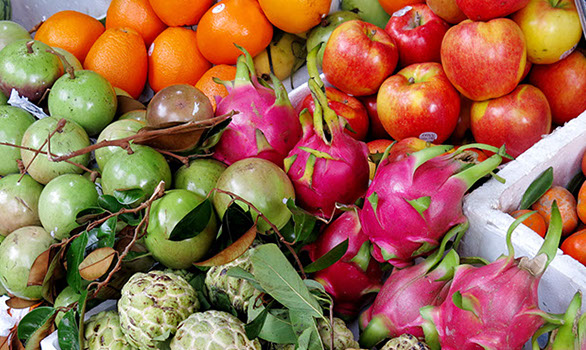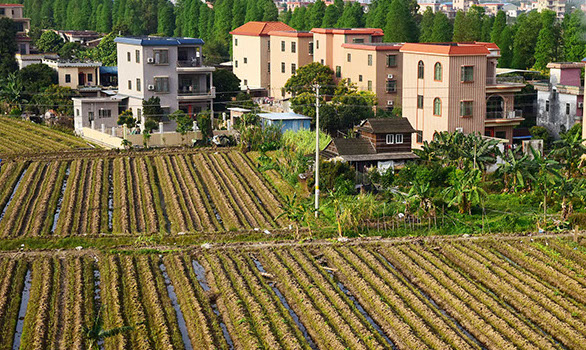
Gaps In
The Food Chain
Politics and commerce, as much as physical factors, can influence whether our food is f it for consumption.
A high-risk product – mussels – exported from a clean environment in New Zealand.

For most consumers, the pursuit of safe food is relatively straightforward: buy from reputable sellers, check expiry dates, wash vegetables and fruit. But well before food arrives at the market, a whole slate of factors will have affected whether that food was fit for consumption.
Food safety is a growing field of study, and a growing challenge for the world. Not only are there environmental problems to deal with, in particular water and soil contamination, but supply chains and the trade and marketing of food are creating conditions that require more technology and regulation.
Professor Harold Corke of the School of Biological Sciences has been studying food safety in terms of both the science – he researches new food materials, such as an anti-microbial film that can keep food fresher for longer in transport – and the management required to feed a growing world population. The supply chain is a particular challenge because hot, humid weather, a lack of knowledge about food safety among small-scale food processing companies and the longer distances food travels to reach global markets, can result in food spoilage and contamination. All these problems can be seen across Asia.
“I think most safety problems come from people making mistakes, not bad intentions,” he said. “The mistakes happen if they don’t know the microbiological history of a product or they become accustomed to doing things in a traditional way and then start to package and sell it to a wider market without sufficient research and development to test the safety parameters for packing and storage.”

![]() Food safety is different from most other regulated activities. The law cannot simply order you to ‘produce safe food’ and expect immediate compliance.
Food safety is different from most other regulated activities. The law cannot simply order you to ‘produce safe food’ and expect immediate compliance. ![]()
Professor Harold Corke
Market forces
One way to change this is to let market forces do their work. Globalisation is helping to lift food safety standards in poorer countries because their overseas buyers want better product compliance. Rising economic standards at home are having an even greater impact.
In China, for instance, small-scale producers are being replaced by larger local companies interested in brand recognition. “The middle class in China is concerned about food safety and willing to pay extra money for it. In the past when people didn’t have the money, everything was based on the cheapest price,” he said.
Regulation is another way of improving food safety, although it is much easier said than done. To illustrate the difficulties, Professor John Burns, Dean of the Faculty of Social Sciences, compared how Hong Kong, Taiwan and Beijing dealt with bird flu outbreaks in chickens and the 2008 melamine in milk scandal.
The response to bird flu was affected by politics. Hong Kong, with its more streamlined bureaucracy and relative lack of chicken producers, was able to effectively close its live chicken markets to contain the outbreak. But this was not possible in Beijing and Taiwan, where strong agricultural lobbies blocked or watered down market closures. In all cases, the consumers never paid the true cost of buying live chickens, which should factor in keeping markets clean, hospital bills and avian flu monitoring systems, he said.
The melamine scandal arose from misguided policy and regulator failure. Households in some parts of China were encouraged to keep a cow and sell the milk to middlemen who then sold it to dairies. But the farmers did not have the necessary resources to optimise milk production so the middlemen added melamine to boost protein levels, which fetched a higher price. The main company involved, Sanlu, knew about the problem as did the Government, which sat on it until the 2008 Olympics were concluded.

Markets bring the products of multiple complex supply chains to the consumer.
Governance matters
“Commercialisation helps to pressure companies, but how do you explain Sanlu?” Professor Burns said. “They didn’t care about the brand. The shareholders, including the Government, only cared about short-term economic profit. It takes time for people to see food safety from a long-term perspective. This is why food safety governance is so important. We need more research in this area.”
Which is not to say that food safety governance will be easy to achieve. Professor Corke pointed out: “Food safety is different from most other regulated activities. The law cannot simply order you to ‘produce safe food’ and expect immediate compliance. Regulation has to be supportive and guidance and training provided, particularly for smaller companies. The possibility of failure also has to be accepted – not all food will be safe always.”
And behind all this discussion is one big challenge for food safety: the vast and growing demand for safe food in China. Professor Corke said while the country had done well in feeding itself, it still needed to improve the environment, supply chains and regulatory enforcement of food safety. “There is nothing more central to Earth as a habitable planet than the ability of China to feed
1.3 billion people safe and high quality food,” he said.

Urbanisation puts pressure on China's agricultural land and water supply.
Next

